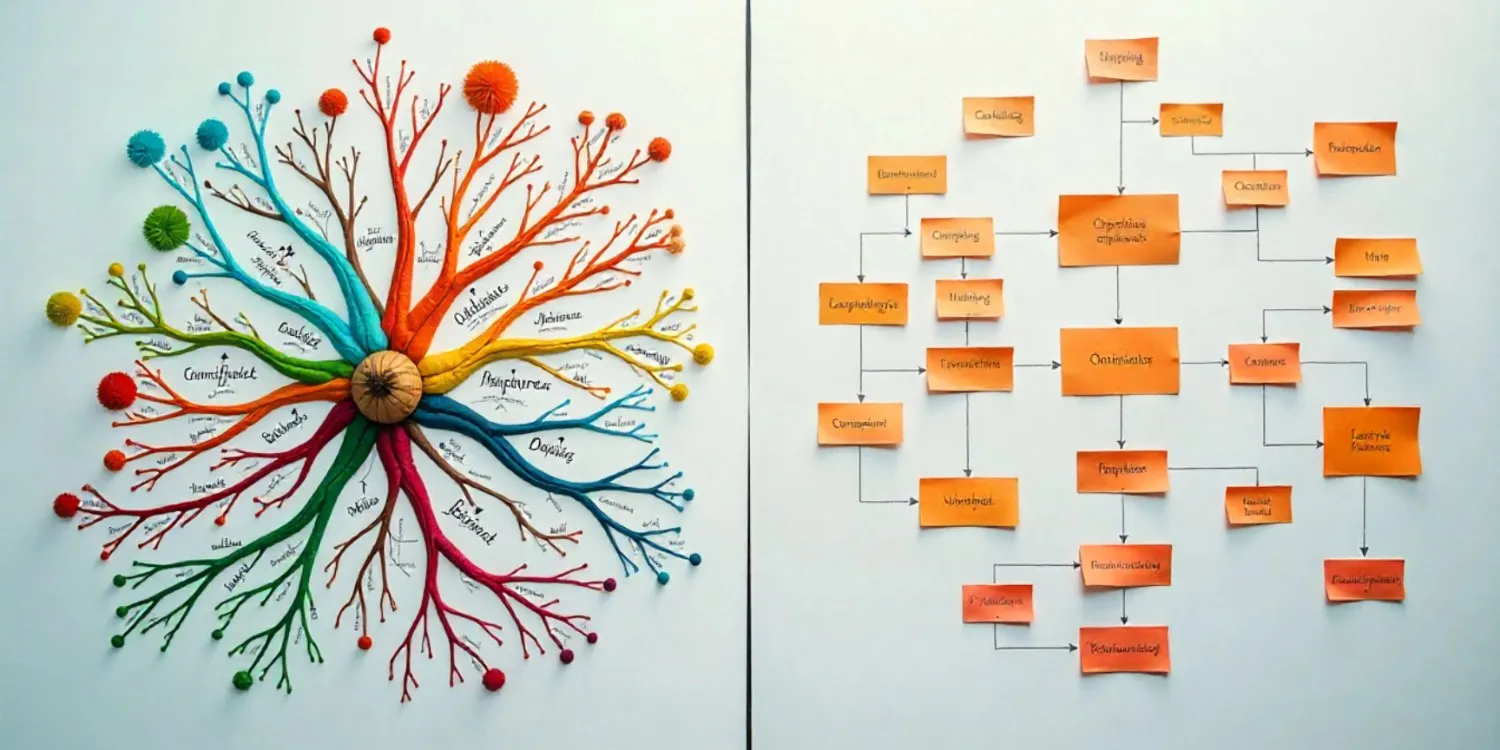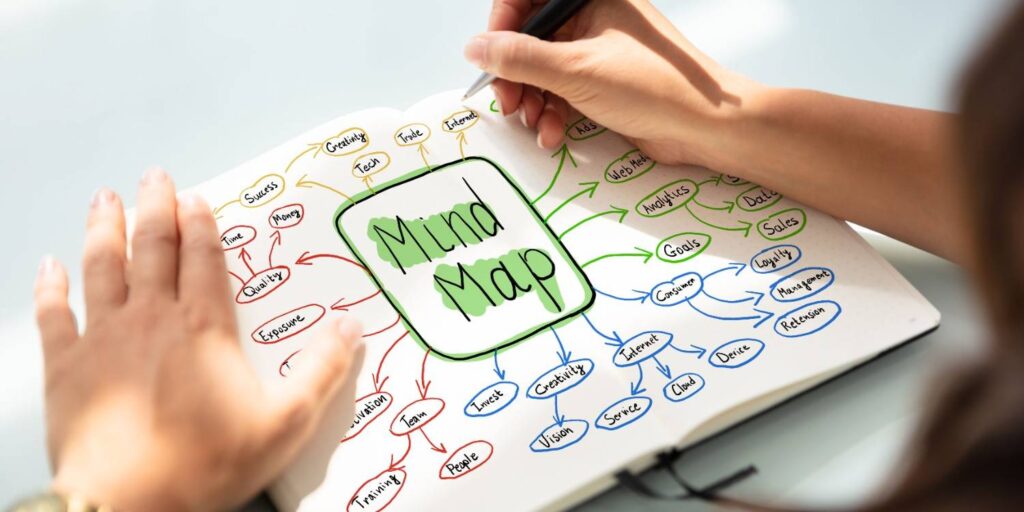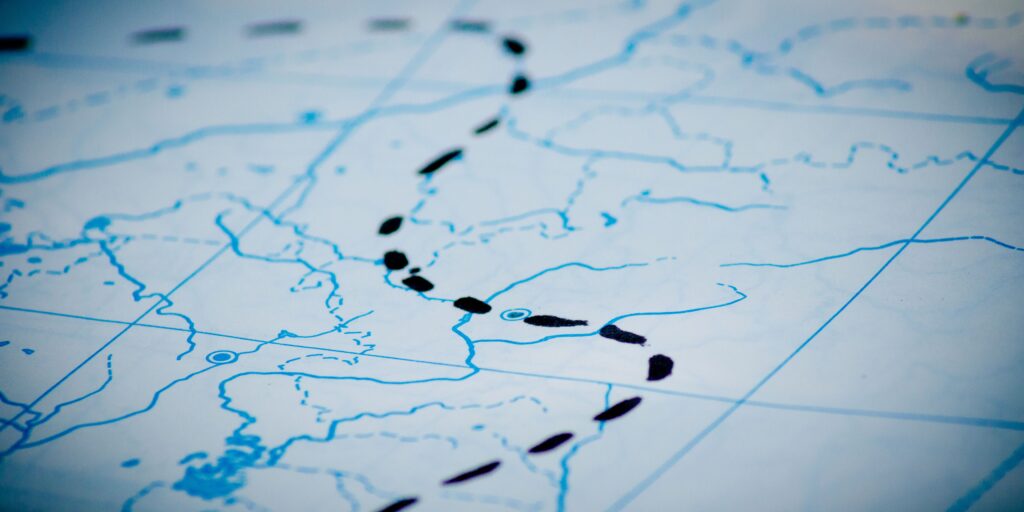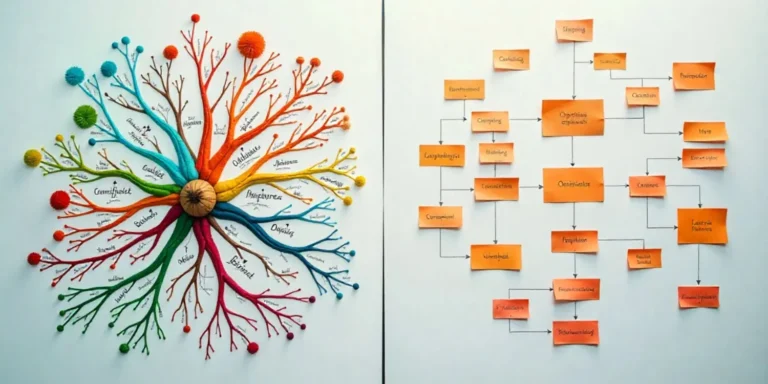Mind maps and concept maps both simplify complex ideas, but they serve different purposes. Mind maps spark creativity and free thinking, while concept maps provide structure and clarity. Choosing the right tool depends on your goal—brainstorming or organizing knowledge effectively.
The Difference Between Mind Map and Concept Map Explained

In an age of information overload, the ability to simplify, organize, and communicate knowledge is more important than ever. Whether in education, business, or personal growth, visualization tools have become essential for turning complex ideas into clear, easy-to-understand structures. Instead of struggling with long documents or endless notes, diagrams help learners and professionals alike see the bigger picture. Among these visualization tools, mind maps and concept maps are two of the most widely used methods.
At first glance, the two may appear similar. Both rely on diagrams, nodes, and connections to represent knowledge. However, the way they are built, the purpose they serve, and the situations where they shine are very different. To use them effectively, one needs to understand what sets them apart, how they developed, and what real-world benefits they provide.

Simple Body weight Exercises You Can Start Immediately
No gym needed! Simple body weight moves like squats, push-ups & planks boost strength, energy & flexibility. Start today, stay consistent!
Read More..
ADVERTISEMENT
What is a Mind Map?
A mind map is a creative diagram that places a single idea at its center and allows related thoughts to radiate outward like the branches of a tree. This technique was popularized in the 1970s by Tony Buzan, who believed that mind mapping reflected how the human brain naturally processes associations.

Mind maps are typically colorful and use single keywords, symbols, and sometimes even images to spark creativity. They begin with a main idea in the middle, such as “Marketing Strategy,” and then expand into broad categories like “Social Media,” “Advertising,” or “Customer Engagement.” Each of these categories can branch into more specific thoughts such as “Instagram Campaigns,” “Paid Ads,” or “Customer Feedback.”
What makes a mind map unique is its non-linear and flexible nature. It does not force ideas into strict hierarchies but instead encourages free thinking and quick idea generation. This makes it especially effective during brainstorming sessions, personal goal setting, and early-stage planning when imagination is needed more than strict order.
Also Read: Get a Fresh Perspective in Your Committed Relationship!
What is a Concept Map?
Unlike a mind map, a concept map is designed to present structured knowledge and show how different concepts are connected through clear, logical relationships. The concept map was developed in the 1970s by education researcher Joseph D. Novak, who wanted to create a better way for students to organize and retain information.

Concept maps usually begin with a broad, overarching idea at the top, such as “Climate Change.” From there, sub-concepts like “Causes,” “Effects,” and “Solutions” are connected through labeled arrows. For example, a link might state that “Greenhouse Gases cause Rising Temperatures” or “Rising Temperatures lead to Melting Ice Caps.” Each relationship is defined, which makes the map easy to read and scientifically accurate.
Where mind maps thrive on creativity, concept maps excel at structure and clarity. They are particularly useful for explaining academic theories, research findings, and project workflows because they provide a detailed overview of how one concept relates to another.
Also Read: The Ultimate Guide to Local SEO
Key Similarities Between Mind Maps and Concept Maps
Both mind maps and concept maps are powerful visualization tools that transform abstract information into digestible formats. They encourage active engagement, improve memory retention, and help learners and professionals organize their thoughts in a more efficient way. Each can be drawn by hand or created using digital tools such as MindMeister, XMind, or CmapTools. Most importantly, they both help bridge the gap between scattered ideas and organized knowledge.
Main Differences Between Mind Maps and Concept Maps
Although they share some similarities, the difference between a mind map and a concept map becomes clear once we examine their structure, purpose, and application.
Mind maps are built around a central theme and radiate outward in a branching pattern. They are best suited for creativity and brainstorming, where the goal is to capture as many ideas as possible without worrying about order. Concept maps, in contrast, are arranged hierarchically. They emphasize clarity and connections, showing how one concept is related to another.
The purpose of a mind map is to generate ideas and inspire free thinking, whereas a concept map focuses on explaining and analyzing existing knowledge. Mind maps are highly visual and often filled with colors and images, while concept maps rely more on linking words and phrases to create precise meaning.
In practice, a mind map might be used to plan a new business campaign by throwing all potential ideas onto paper, while a concept map would be used to break down the structure of the campaign, showing how different departments, tasks, and goals are interconnected.
Don’t Miss These
Real-World Applications of Mind Maps
Mind maps have become invaluable in education, business, and personal growth. In classrooms, students often use them to summarize chapters, prepare for exams, or generate essay outlines. By visualizing information such as “Causes of World War II,” they can quickly identify relationships between events without reading lengthy notes.
In the business world, mind maps are commonly used in brainstorming sessions. Teams can gather around a whiteboard and map out potential product features, marketing strategies, or sales campaigns. The free-flowing nature of a mind map makes it easy to capture spontaneous thoughts, encouraging collaboration and creativity.
On a personal level, individuals create mind maps for goal setting, daily planning, or habit tracking. For example, someone who wants to improve their health might create a central idea labeled “Healthy Lifestyle,” branching out into areas such as “Diet,” “Exercise,” and “Mental Wellness,” each of which can expand into more specific actions.
Real-World Applications of Concept Maps
Concept maps are particularly powerful in contexts where clarity and structure are essential. In academic research, they help students and scholars organize theories, literature reviews, and study results. A psychology student, for instance, might create a concept map to explain how different cognitive processes like memory, attention, and learning are interrelated.
In project management, concept maps are used to link project goals with tasks, resources, and deadlines. The labeled connections make it clear which steps depend on others and which outcomes are expected at each stage. This makes them especially effective in complex projects where communication and organization are critical.
In organizations, concept maps are widely used for knowledge management and training. They allow companies to present information in a way that employees can easily understand, ensuring consistency in processes and decision-making.
Pros and Cons of Each Tool
Mind maps and concept maps each come with their strengths and limitations. Mind maps are highly engaging and encourage creativity, making them ideal for quick idea generation and free-flow exploration. However, they can become overwhelming and disorganized if too many branches are added. On the other hand, concept maps provide clarity and logical structure, which makes them perfect for complex systems and academic work. Their drawback is that they can be time-consuming to create and less flexible when it comes to spontaneous brainstorming.
Which One Should You Use?
The choice between a mind map and a concept map depends entirely on your goal. If you are in the early stages of a project and want to brainstorm or explore possibilities, a mind map is the better option. It allows for creativity and helps you generate ideas quickly. However, if your task requires analyzing, explaining, or organizing detailed knowledge, a concept map will serve you better.
In simpler terms, use a mind map when you want to generate ideas and a concept map when you want to explain ideas. Many professionals find value in using both tools at different stages of their work. For example, a marketing team might start with a mind map to brainstorm campaign ideas and later create a concept map to organize the final plan.
Conclusion
Mind maps and concept maps are both effective methods of turning abstract information into visual clarity, but their functions differ significantly. A mind map is ideal for free-flowing creativity, while a concept map is best for structured analysis. The difference between mind maps and concept maps lies in their design, purpose, and applications.
By understanding these differences, individuals, and organizations can choose the right tool for the right situation. Whether you are a student preparing for exams, a professional managing a complex project, or someone simply looking to plan personal goals, selecting the appropriate visualization method can make the process more efficient and impactful. Ultimately, the question is not which tool is better, but which tool is better suited for your specific needs.
You May Also Like
Home and Travel: Why You Can’t Cherish One Without the Other For me, home and travel are incomplete without each...
The Difference Between Mind Map and Concept Map Explained Mind maps and concept maps both simplify complex ideas, but they...
It starts with a simple notification. You pick up your phone to check one message, and suddenly, 30 minutes are...
SPONSORED

It’s Okay to Take a Little Time Away From Your Child – Don’t Feel Guilty!
Monis Ali September 8, 2025
It’s Okay to Take a Little Time Away From Your…
Read More
Things Fade Away, But Memories Last Forever
Monis Ali August 21, 2025
Why Memories Outshine Material Things Have you ever looked at…
Read More
How a No-Oil Diet Can Transform Your Body and Skin
Monis Ali August 11, 2025
Imagine waking up one morning, looking in the mirror, and…
Read More
How Much Are You Doing to Keep Your Brain Healthy?
Monis Ali September 14, 2025
How Much Are You Doing to Keep Your Brain Healthy?…
Read More
Want a Healthy Life? Start With These 5 Morning Rituals.
Monis Ali September 3, 2025
Want a Healthy Life? Start With These 5 Morning Rituals…
Read More
Simple Body weight Exercises You Can Start Immediately
Monis Ali August 25, 2025
Have you ever thought about starting a workout routine but…
Read More
Why Your Shine Deserves the Perfect Jewelry
Asif September 12, 2025
Why Your Shine Deserves the Perfect Jewelry This blog explores…
Read More
Get a Fresh Perspective in Your Committed Relationship!
Asif September 6, 2025
Get a Fresh Perspective in Your Committed Relationship! Love doesn’t…
Read More
Adventure Tourist’s Guide To Antarctica
Asif September 3, 2025
Embark on the last great adventure to Antarctica—discover the best…
Read More





